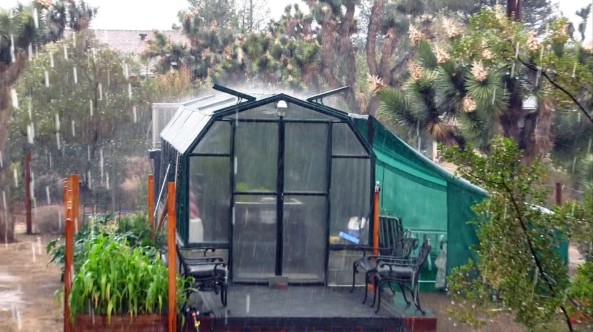In late July the desert monsoons hit and refreshed everything with a down pour of wonderful wetness from above. This photo is a picture of that event. But wait until you see what is growing inside our rain soaked Greenhouse!

Every now and then wonderful summer monsoons hit the high desert of California. This was one of those days.
We have Corn. So much Corn it’s growing right out of the roof vent. Corn that started out as pitiful, wispy weak looking leaves, which you can see in the center Grow Bed in the next photo (which we’ve posted before). We want you to see what has happened in six weeks of time to those little plants.
Better yet, watch the progression (someone suggested we do time-lapse photos) so that’s what we’re showing. Here’s a photo that was taken about three weeks after the one above.
Then comes the most recent pictures that were taken six weeks after the first shot with the wispy Corn. These Corn stalks are so thick, they resemble bamboo; and the Corn is growing all the way up to the top of the Greenhouse roof. It’s an amazing sight to see.
The male part of the Corn flower is sitting above the silk at the top of the picture. You need both the tassel looking male flowers and the silk to get corn. Here’s why.
“Corn is monoecious (mon-ee-shuss) which means that there are both male and female flowers on each corn plant. In some monoecious plants, male and female parts are in the same flower. In corn, male and female flowers are in different locations – the male flowers form a tassel which is at the top of the plant. The female flower is located at the junction of leaves and stem. It consists of a collection of hairs (silks) enclosed in the husks of what will become the ears. These silks are pollen-receiving tubes. Wind-blown pollen from the male flowers (tassel) falls on the silks below. Each silk leads to a kernel, and pollen must land on all silks for the ear to fill out completely with kernels. Kernel “skips” (ears only partly filled out with kernels) often are the result of poor pollination. ” (from Growing Sweet Corn in the Backyard Garden)
Last year we planted corn for the first time but never got actual corn to eat. Actually, we didn’t really plant it. We placed a group of rockwool cubes with corn seeds in them in a back Grow Bed, never separated them from each other and just waited to see what would happen. Corn grew but it didn’t pollinate because the plants were too crowded together; and they were competing with tomatoes. Anytime a plant tries to compete with tomatoes, it loses because tomatoes take every bit of the nutrients from the water in order to put out fruit.
So this year we decided to get serious about planting Corn; and it looks like we’re going to be eating Non GMO Corn on the cob soon. We’ll be blogging all about that joyous occasion. In the meantime, just watching this Corn grow is an event all of its own. Below is a photo of one stalk growing right out of the Greenhouse roof vent.

This stalk is going to prove once and for all if we can actually get cobs of corn as it’s not being stopped by the roof. For this stalk, the sky is the limit.
In the background of the above photo is Greek Basil. It’s also loving this environment and is growing into lovely bushes of luscious smelling basil.
So that’s what’s going on inside the Aquaponics USA Greenhouse this summer. Not to mention the R&D for our commercial-sized Food Forever™ Farm Systems that we’re designing under our new business, at Aquaponics World.net. We can’t show you that Grow Bed as the new designs are proprietary. But I can tell you it’s getting real exciting around here right about now.
Thanks for visiting. All the effort, wouldn’t be nearly as much fun if we didn’t have you to share it with.






It�s difficult to find knowledgeable people on this topic, but you seem like you know what you�re speaking about! Thanks
LikeLike
yes..I’m involved in thinking about and planning an experimental aquaponic project for farming rice and corn using a mix of cat fish, tilapia, and red worms. My guess is that a green house maybe too expensive to cover a one hectare area…but the fish pen might be covered. I’m toying with rectangular cross-section grow tubes (DIY Fiber Reinforced Plastic) with non-woven polyester media. I don’t want the expense of ultra-violet grow lights. The project also involves coconut palms and a variety of vegetables; okra, kidney beans, carrots, onions and tomatoes. Crop density experiments will evaluate the optimum crop yield for various angles from 70 degrees to vertical. Please comment
LikeLike